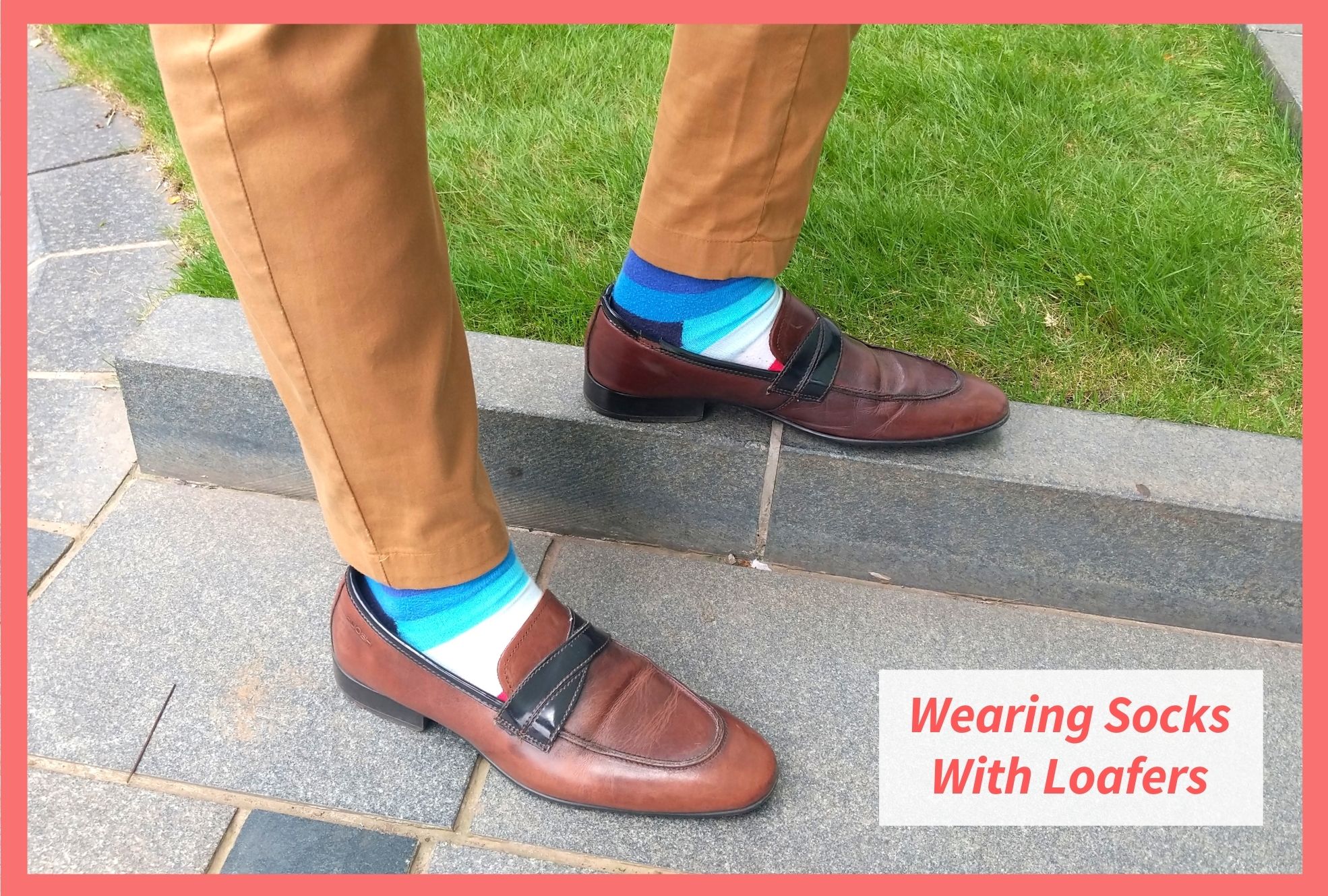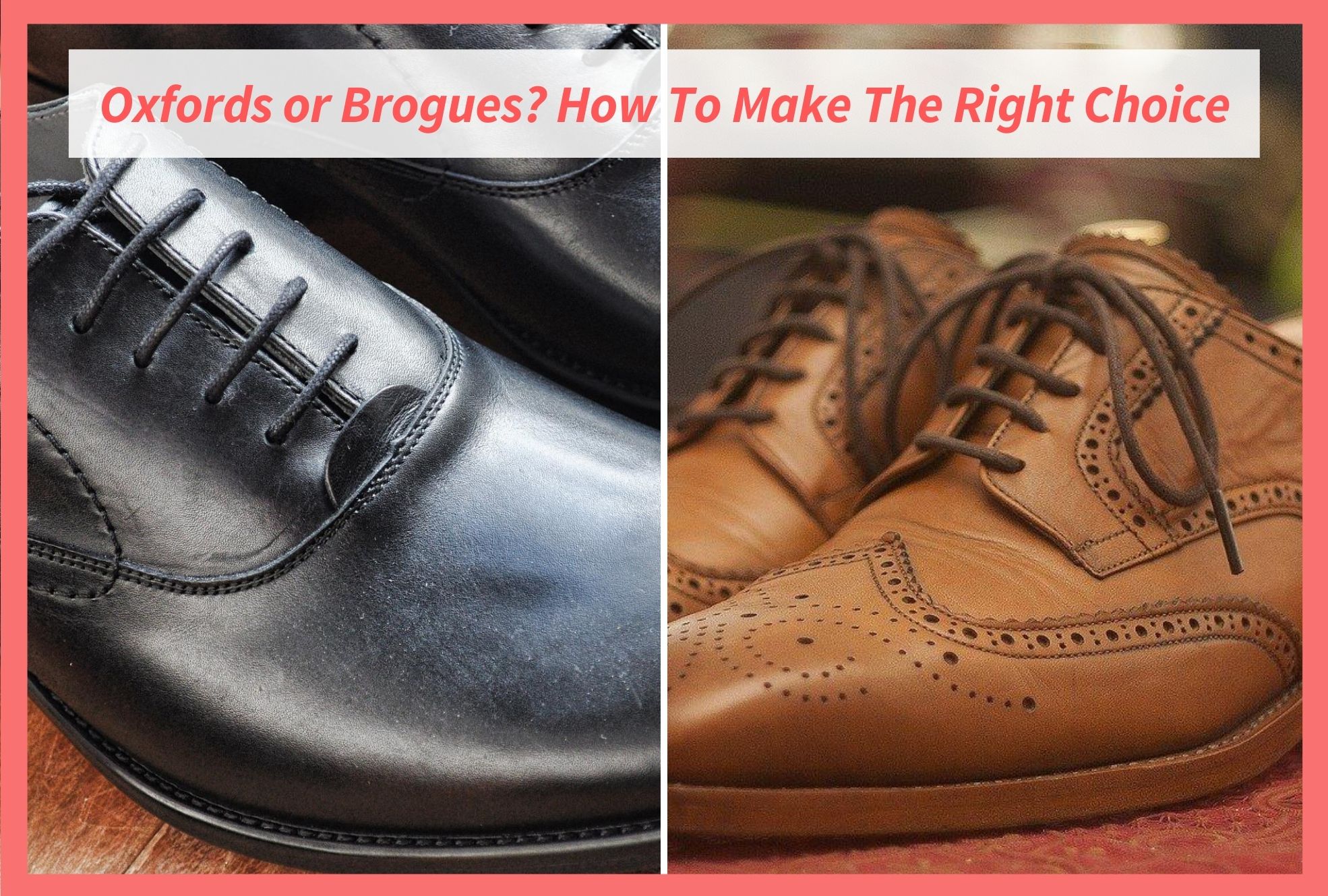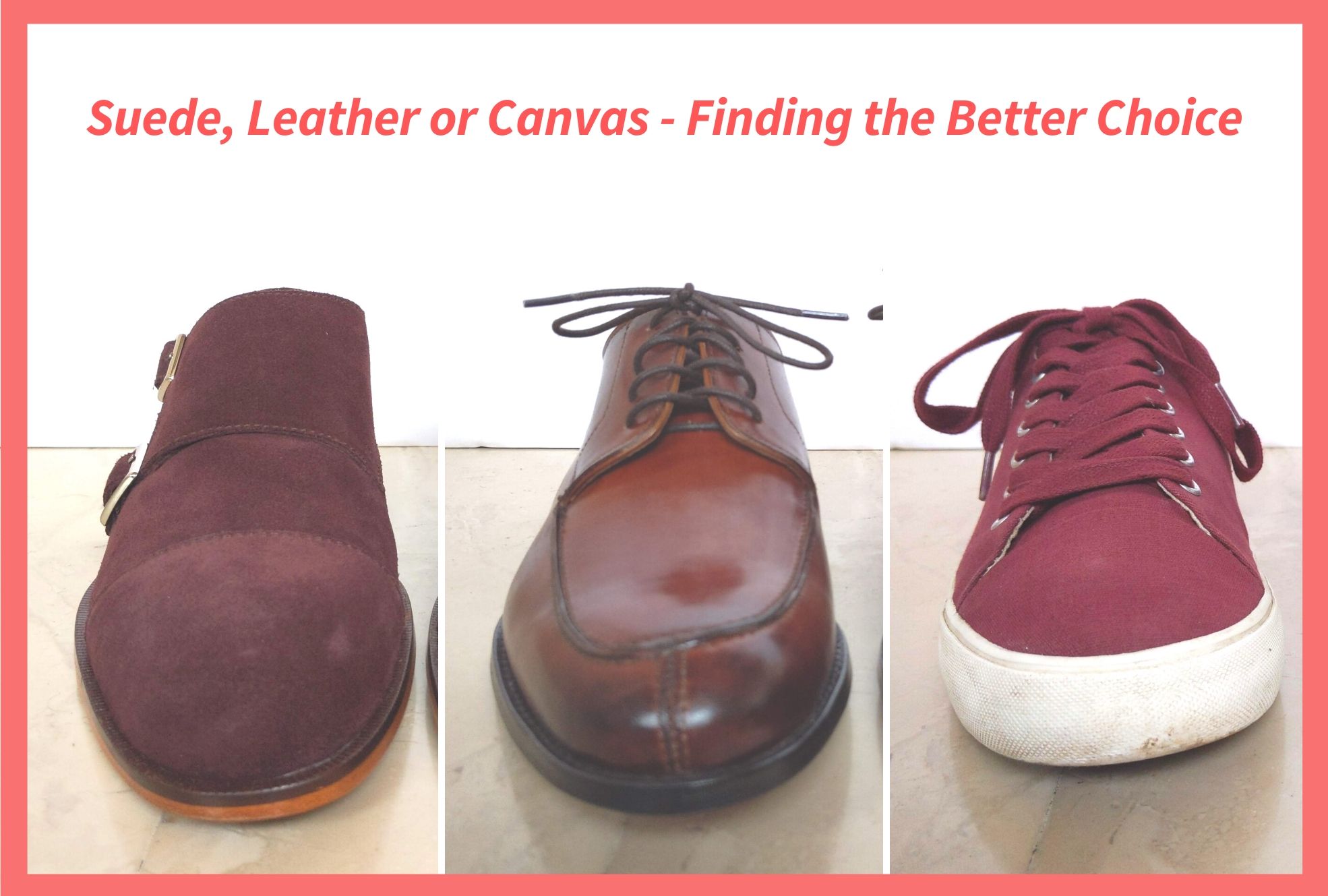Trends come and go, but the classics remain. This applies to shoe-lacing too – there are a lot of fun lacing techniques and you can try out all of them, but the traditional techniques mentioned in this article will always look good
Laced dress shoes will either be oxfords or derbies, both of them have a separate way of lacing that work best with that particular style. Traditionally, oxfords will be straight-laced where the laces look like parallel bars moving from one side of the eyelet to the other. This kind of lacing is the most formal, in contrast to the cross lacing used for derby shoes which is one step down the formality scale but still very dressy. In cross lacing, the laces move from one side of the eyelet to the other so as to form a cross (x)

This article lists the step-by-step method for both straight lacing and cross lacing. It also talks about the one lacing style that you should avoid when it comes to dress shoes and provides some more information about shoelace lengths and shoelace types
Straight Lacing / Bar Lacing for Oxford Shoes
The right way to lace Oxford shoes is straight, where the laces are parallel and straight. This adds to the clean look that oxfords provide and can be done for both odd or even number of eyelets
Oxford shoes will almost always come laced this way out of the box, so you’ll need to apply this method only when you decide to change your shoelaces, or remove them while cleaning the shoes
Most Oxford shoes have 5 eyelets though, which is used as a base reference for these steps-
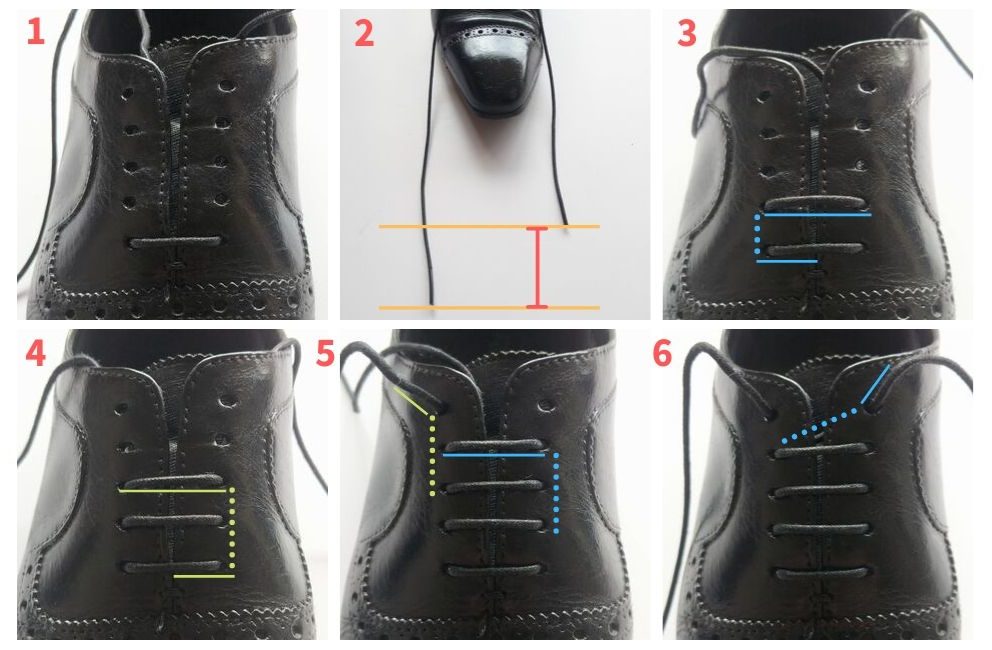
The dotted lines indicate laces passing through on the inside
- Start by putting both ends of the laces across the bottom eyelets from the outside
- Pull both ends and keep the one on the outer part of the shoe about 3″ longer for odd eyelets.
For even number of eyelets, both ends should be at the same length - Insert the end on the outer part into the second hole on the same side, from the inside. Put it into the second hole on the opposite side
- The end that was inserted in the first hole on the opposite (inner) side should be put into the third hole on that side. Then put this end straight across to the outer side in the third hole
- Keep going up in this manner, both ends skipping one eyelet on the inside and going straight across to the other side
- For an odd number of eyelets, one eyelet will be left empty towards the end and you’ll have to make a cross from one hole below on the other side. This is why we had kept one side longer.
For even eyelets, all would be covered equally so no cross will be required.
Cross Lacing for Derby Shoes
Like the name suggests, the two sides of the laces in this technique meet each other in a criss-cross manner – making it the strongest method of fastening your shoes. It is ideal for shoes that are a bit less formal than oxfords, like derbies, boots, and even sneakers.
I have also rarely found this lacing on shoes out of the box, so if you’re thinking of going for this method (and you should), you’ll have to do it from the get-go
Although derbies can be straight-laced too, I personally feel that cross lacing looks better on this style
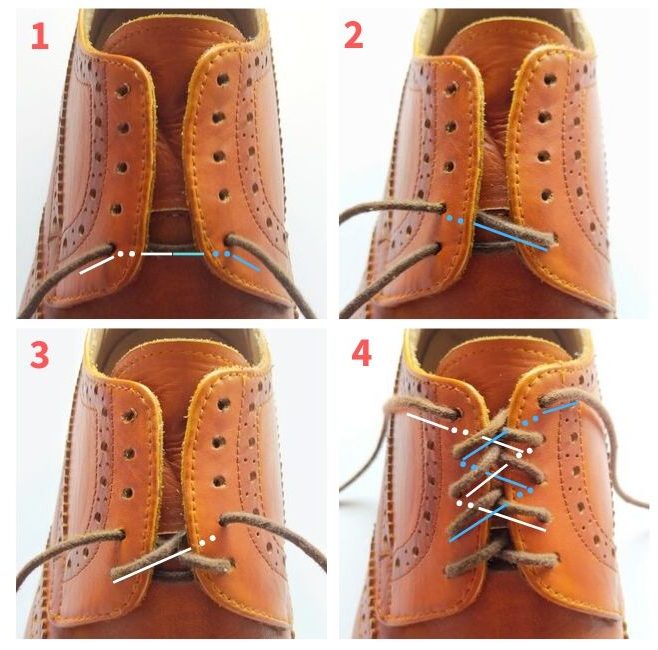
The dotted lines indicate laces passing through on the inside
- Take both ends of the laces and insert them across the bottom eyelets, forming a bar like in step 1 of straight lacing shown above
- Ensure that both ends are at the same length. Take the end on the inner part of the shoe and put it through the second eyelet on the other side
- Then insert the end on the outer part of the shoe in the second eyelet on the inner side – crossing over the diagonal lace in step 2
- Repeat steps 2 and 3 till all the eyelets are covered. Both ends should now be coming out from below the topmost eyelet.
The Lacing Style You Should Avoid – Factory lacing
If you’re wondering what the faux bar lacing on your new pair of derbies is called, this is probably the answer. Also called shoe shop lacing, shoes are generally laced this way in the factory before dispatching them. It gives the appearance of bar lacing at first, but look closer and you’ll see that the laces actually move upwards in a zig-zag manner on the inside
Since one end of the lace is enough to achieve the zigzag pattern of this lacing style, the other end (on the outer part of the shoe) runs directly and diagonally to the topmost eyelet on the opposite side
The reason it is not advisable to keep your shoes laced this way is because of the asymmetry across both ends. Although it is easier and faster to factory lace shoes, the laces are uneven on the inside even if they look straight on top. This can cause a lot of tension on the eyelets while tying the shoes and make them out of alignment over time
A note on shoelace lengths
The laces that come with your shoes should last you a long time – some even offer an extra pair in the box. But if yours wear out soon, or if you’re planning to switch up with fun colored shoelaces (yes it’s a thing!), it would be good to know the appropriate lengths for various shoes
The easiest way to decide on shoelace length is as per the number of eyelet pairs on the shoe. The approximate value ranges are as below –
| Number of eyelet pairs | Length in cm | Length in inches |
| 3 (Chukka Boots) | 58 cm | 23 inches |
| 4 | 69 cm | 27 inches |
| 5 (Most dress shoes) | 91 cm | 36 inches |
| 6 | 102 cm | 40 inches |
| 7 | 114 cm | 45 inches |
| 8 ( High Top Boots) | 137 cm | 54 inches |
| 9 | 160 cm | 63 inches |
| 10 | 183 cm | 72 inches |
Laces for Dress Shoes: Flat or Cylindrical?
If we are talking about keeping it traditional, dress shoes should be worn with cylindrical shoelaces since they are more formal than flat laces. You will find flat shoelaces on most sneakers because of their casual look.
Neither is better than the other because both can be used differently. Boots will have thick round laces which are sturdy and durable while those of dress shoes are thinner and more susceptible to snapping and tear. Flat shoelaces will come undone far less often than round ones – that’s why they are used on casual or running shoes.
Can you use flat shoelaces on dress shoes? Why not! They can distinctly change the look of your shoes. Just make sure they are thin enough to pass through the shoe eyelets, and preferably go for waxed cotton ones – cheap quality shoelaces won’t look good or last long
Summary:
Straight and cross lacing constitute the two most classic ways to lace your dress shoes. As a rule of thumb, oxford shoes are meant to be straight-laced while derbies have the versatility of looking good with both the methods.
Cross lacing is the most secure of the two, making it difficult for your laces to come undone.
My suggestion would be to try both of these methods and see the comfort levels in each. Don’t be afraid to experiment, it will only get you one step closer to developing your own sense of shoe style 🙂


